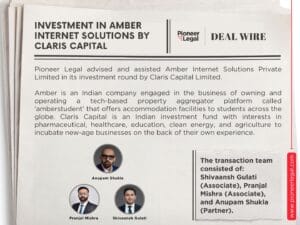India has improved its Ease of Doing Business Rankings in 2019 and jumped to 77th place out of 190 from 130th in 2016. There has been an obvious improvement in ease of doing business in India in the past three years. But there are 76 countries ahead of us, which means there are still considerable hurdles for doing business in India which need to be removed for us to forge ahead on that list. Now Covid-19 has destroyed with ruthless abandon any “ease” that individuals and entities have had in doing any business or other economic activity in this financial year, but we are trying to look at the ease or the lack thereof in doing business that existed before Covid-19 and will continue to plague our economy after the pandemic has subsided.
Let’s take an example. One of our clients was looking at a merger of two of its entities in India as part of an internal restructure. One of the two entities was listed on two stock exchanges in India. Any merger involving a listed entity requires a detailed scheme of merger being first approved by the concerned stock exchanges, then SEBI and thereafter by the National Company Law Tribunal (“NCLT“). In our case, when the scheme of merger was presented before the stock exchanges, they requested certain additional information, which was provided by the client. However, one stock exchange asked for details of all disciplinary actions taken by any regulatory authorities against the promoters of the listed entity (namely our client) and all other companies promoted by the promoters.
The term “companies promoted by promoters” is not defined by SEBI in its regulations. It is akin to the term “promoter group” which includes an entity in which the promoter holds 10% or more of the equity share capital. Now this client is an MNC and there are more than 250 entities in almost 50 different countries in which it holds 10% or more equity. In most jurisdictions, holding 10% equity in a company will not allow the shareholder to dictate to the management of such company to produce such records. This would be a massive exercise. This requirement is also not mentioned in any by-laws of the stock exchange which would give a fair warning to the client of what information requests to expect.
What does disciplinary action include? Does it include only litigation or also notices received that may lead to litigation? What is the period for which the information is required? Is there a materiality threshold in terms of monetary value or penalty under such disciplinary action? We sought clarity from the stock exchange on the above, but no written clarity was forthcoming.
To put this in context, SEBI mandates that for an IPO, an issuer is required to provide information on all material litigation/liabilities/defaults including arrears/potential liabilities of the issuing company, its promoters/controlling shareholders/directors and its subsidiaries and associates. This does not include information on other companies “promoted by the promoter”. The materiality of the litigation/liabilities/defaults is to be determined by the concerned company based on certain prescribed parameters. In the end, the client did undertake the massive exercise of collating all the information, as the application for approving the merger would not move forward without this.
After the long delay, NCLT finally approved the merger, but predictably enough, the inefficiency of our judicial system reared its ugly head. After the final hearing, on which NCLT approved the merger, it took them two months to issue a written order. After receipt of such an order, the merging entities are required to file a copy of the order with the Registrar of Companies (ROC) and the merger becomes legally effective. The only important action required thereafter is the issue of shares of the resulting entity to the shareholders of the merged entity. Sounds easy enough, but remember we are in 77th position on the ease of doing business rankings.
In this case, the ROC refused to take the filing of the order on record. The reasons as conveyed by them include pending claims and forms of the merging company in their records. The whole idea of a merger is that the resultant company acquires all the liabilities and assets of the merging entities. Any third party or regulatory body with any claim or any reason as to why a merger should not happen is invited to raise their objections before the NCLT. After the NCLT passes an order approving a merger and it is filed with the ROC, all pending claims, liabilities and litigation of the merging entity (or of the division which is being transferred) are transferred to the resultant entity. There is no rhyme, reason or a defined process for ROC to not take the order of NCLT on record. Now in our case, since one of the merging entities is listed, there are legally prescribed time limits within which the resultant company has to issue shares and have such shares listed on a stock exchange. With the ROC not taking on record the merger, the authorized share capital of the resultant entity does not reflect the post-merger number thereby not providing enough head room for the company to issue shares. One branch of the regulatory machinery is forcing a company to fall foul of regulatory requirements prescribed by another authority.
After all the delays and the expenses of financial advisors, lawyers etc., the restructuring process has still not been completed as the ROC has refused to take the filing on record. It has now been two years since we started this exercise and the solution to this problem is still not in sight.
Disclaimer: This article is meant for information purpose only and does not purport to be advice or opinion, legal or otherwise, whatsoever. Pioneer Legal does not intend to advertise its service through this article.












































